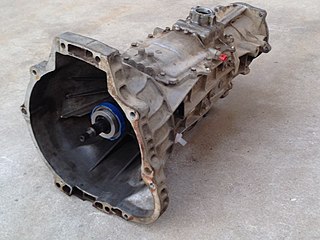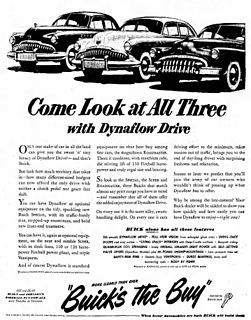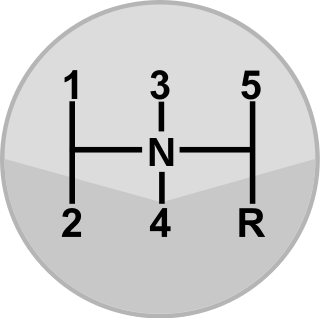Related Research Articles

An automatic transmission is multi-speed transmission used in motor vehicles that does not require any driver input to change gears under normal driving conditions.

A transmission is a machine in a power transmission system, which provides controlled application of the power. Often the term 5-speed transmission refers simply to the gearbox that uses gears and gear trains to provide speed and torque conversions from a rotating power source to another device.

A manual transmission is a multi-speed vehicle transmission where gear changes require the driver to manually select the gears by operating a gear stick and clutch.
Semi-automatic transmission denotes a multi-speed motor vehicle transmission where part of its operation is automated but the driver's input is still required to start from a standstill and to manually change gears. Most semi-automatic transmissions used in cars and motorcycles are based on conventional manual transmissions or a sequential manual transmission, but use an automatic clutch system. However, some semi-automatic transmissions have also been based on standard hydraulic automatic transmissions, with a fluid coupling or torque converter.

Hydramatic is an automatic transmission developed by both General Motors' Cadillac and Oldsmobile divisions. Introduced in 1939 for the 1940 model year vehicles, the Hydramatic was the first mass-produced fully-automatic transmission developed for passenger automobile use.

TorqueFlite is the trademarked name of Chrysler Corporation's automatic transmissions, starting with the three-speed unit introduced late in the 1956 model year as a successor to Chrysler's two-speed PowerFlite. In the 1990s, the TorqueFlite name was dropped in favor of alphanumeric designations, although the latest ZF-based transmissions with the eight-speed automatic has revived the name.
Ultramatic was the trademarked name of the Packard Motor Car Company's automatic transmission introduced in 1949 and produced until 1954, at Packard's Detroit, Michigan East Grand Boulevard factory. It was produced thereafter from late 1954, thru 1956 at the new Packard "Utica" Utica, Michigan facility.

Dynaflow was the trademarked name for a type of automatic transmission developed and built by General Motors Buick Motor Division from late 1947 to mid-1963. The Dynaflow, which was introduced for the 1948 model year only as an option on Roadmaster models, received some severe early testing in the M18 Hellcat tank destroyer, which were built in Buick's Flint, Michigan assembly plant during World War II. It was also used in the 1951 Le Sabre concept car.
The Powerglide is a two-speed automatic transmission designed by General Motors. It was available primarily on Chevrolet from January 1950 through 1973, although some Pontiac models also used this automatic transmission after the fire at the Hydra-Matic factory in 1953. Powerglides were used extensively on Pontiacs produced for the Canadian market with Chevrolet powertrains. They were also used with Nova engines in the DJ-5A Jeeps produced 1968-1970 by Kaiser-Jeep and widely used as delivery vehicles by the United States Post Office. When introduced on upper-level Chevrolet models in 1950, the Powerglide represented the first automatic transmission offered in a low-priced automobile; in contrast, Ford did not offer their automatic transmission until 1951, while Plymouth car buyers had to wait until 1954. The transmission was simple and very durable, which satisfied customers.

A preselector gearbox is a type of manual transmission mostly used on passenger cars and racing cars in the 1930s, in buses from 1940-1960 and in armoured vehicles from the 1930s to the 1970s. The defining characteristic of a preselector gearbox is that the gear shift lever allowed the driver to "pre-select" the next gear, usually with the transmission remaining in the current gear until the driver pressed the "gear change pedal" at the desired time.
Roto Hydramatic was an automatic transmission built by General Motors and used on some Oldsmobile, Pontiac and Holden models from 1961–1965. It was based on the earlier, four-speed Hydramatic, but was more compact, providing only three forward speeds plus a small 8" fluid coupling with a stator inside of the fluid coupling. Oldsmobile, one of the users of this transmission, called the fluid couplings stator the "Accel-A-Rotor." The lightweight, aluminum-cased transmission was sometimes nicknamed the "Slim Jim." HydraMatic Division calls the Roto a four range, three gear HydraMatic. It counts the stator multiplication at 3.50:1 as a first gear, and when road speed and the two coupling halves speed match, it counts the same gear with fluid now passing straight through the stator as 2nd gear at 2.93 to one. Second gear has a ratio of 1.56 and because the fluid coupling is drained for this gear ratio making the front clutch apply makes this a rare automatic that is in FULL mechanical lock-up in second gear. Fourth range the coupling fills releasing the front clutch makes a ratio of 1 to 1. This transmission, like single and dual range, and dual coupling hydramatics also have the feature of split torque in the transmission whereby in fourth or high gear only 40-to 50% depending on transmission, 40% in Roto's case, but because of the design the coupling is only required to carry 40% of the engine torque. The rest is (60%) is in full mechanical connection making these hydramatics the most efficient automatic until the wide spread use of the lock-up torque converter.
The Ultradrive is an automatic transmission manufactured by Chrysler beginning in the 1989 model year.
A transmission control unit (TCU), also known as a transmission control module (TCM), or a gearbox control unit (GCU), is a type of automotive ECU that is used to control electronic automatic transmissions. Similar systems are used in various semi-automatic transmissions for clutch automation. A TCU in a modern automatic transmission generally uses sensors from the vehicle as well as data provided by the engine control unit (ECU) to calculate how and when to change gears in the vehicle for optimum performance, fuel economy and shift quality.
The M6 Presto-Matic was a Chrysler Corporation semi-automatic transmission produced from 1946–1953. It was a special manual transmission with a fluid coupling. Although it had just two forward gears, an electric overdrive unit was attached and useful in either gear for a total of four forward speeds.
Fluid Drive is the trademarked name that Chrysler Corporation assigned to a transmission driveline combination which replaced the flywheel with a hydraulic coupling and performed the same function as a modern torque converter, only without torque multiplication. A conventional clutch and three- or four-speed manual transmission was installed behind the fluid coupling. Fluid drive was used in many military vehicles produced for the US Armed Forces during the Second World War. It was offered for civilian use from 1939 through 1953 in Chryslers, 1940 through 1953 in DeSotos, and from 1941 through 1954 in Dodge models; a semi-automatic system was optional from Chrysler and Desoto from 1941, and for Dodge from 1949.

A gear stick, gear lever, gearshift or shifter is a metal lever attached to the shift assembly in an automobile transmission. The term gear stick mostly refers to the shift lever of a manual transmission, while in an automatic transmission, a similar lever is known as a gear selector. A gear stick will normally be used to change gear whilst depressing the clutch pedal with the left foot to disengage the engine from the drivetrain and wheels. Automatic transmission vehicles, including hydraulic automatic transmissions, automated manual transmission, older semi-automatic and clutchless manual transmission vehicles, like VW Autostick, and those with continuously variable transmissions, do not require a physical clutch pedal.
The Turboglide is a Chevrolet constant torque, continuously variable automatic transmission that made its debut as an optional transmission on Chevrolet V8 passenger cars for 1957. It consisted of a concurrently geared planetary gearbox with a 'switch pitch' dual-pitch torque converter stator. Turboglide utilized a die-cast aluminum transmission case, following Packard's Ultramatic of 1956. It was designed to help showcase the engineering features of the '57 Chevy, and was often ordered with the Rochester Ramjet Fuel Injection system on the 283 V8. Turboglide cost about $50 more than Powerglide, and was available in all 1957-1961 V8 engine models except the Corvette.
9HP is ZF Friedrichshafen AG's trademark name for its nine-speed automatic transmission models for transverse engine applications, designed by ZF's subsidiary in Saarbrücken and build in Gray Court, South Carolina. It is used in front-wheel drive and all-wheel drive vehicles.

A motorcycle transmission is a transmission created specifically for motorcycle applications. They may also be found in use on other light vehicles such as motor tricycles and quadbikes, go-karts, offroad buggies, auto rickshaws, mowers, and other utility vehicles, microcars, and even some superlight racing cars.

Mopar branded automatic transmission fluids (ATF) have been available for use in Chrysler fully automatic transmissions since 1953. Other Mopar branded fluids for their Fluid Drive semi-automatic transmissions were available as early as 1938. Chrysler used General Motors (GM) automatic transmission fluid specifications from 1952 through 1966 and marketed them under the Mopar brand name. In 1966, Chrysler began releasing their own automatic transmission fluid specifications. Chrysler licenses their ATF specifications to companies which manufacture the fluid and sell it under their own brand names. Not all Chrysler fluids are licensed for reselling under another brand name. All licensed Chrysler fluids must have a license number on the container. If no license number is found, the fluid may not be Chrysler approved and the fluid cannot be guaranteed to meet Chrysler specifications.
References
This article does not cite any sources .(March 2008) (Learn how and when to remove this template message) |